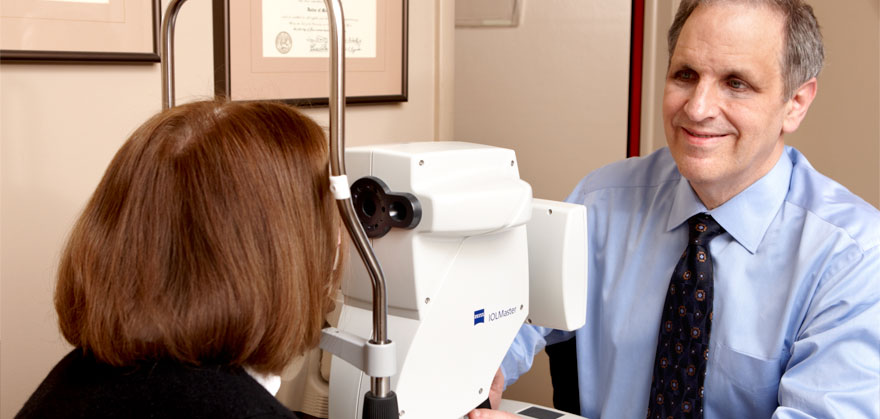What Is a Cataract?
The clouding of the lenses of our eyes, otherwise known as cataracts, is incredibly common as we age. Cataracts are the number one cause of blindness around the world, but there’s really no reason for that. Cataract surgery is simple and incredibly successful.
In the U.S. over 22 million people over the age of 40 have cataracts, and this number is expected to grow to 35 million in a year or two. It’s a 50/50 chance if you’re 80 that you either have cataracts or have already had surgery to remove the natural lens and replace it with an intraocular lens.
Dr. Stuart Sondheimer has extensive experience with cataract surgery at his Skokie practice.
Why Choose Dr. Sondheimer for Cataract Treatment
Dr. Stuart P. Sondheimer has been performing refractive surgery since 1991 and has worked tirelessly to help people see well without the need for glasses. He has been working with doing cataract surgery for over 30 years and uses the latest technologies. He is very experienced helping people discover if monovision, where one eye sees far while the other eye sees near, is a good option. Cataract surgery is a once in a lifetime opportunity to change your vision to see without glasses for distance, intermediate and near.
What Causes Cataracts?
In our eyes, the lens can be found behind the iris and the pupil. The job of the lens is to focus what the eye is seeing on the light-sensitive retina at the back of the eye. When we’re young, the natural lens in our eye is crystal clear. But with age and factors such as sun exposure, proteins in the eye form clumps that begin to cloud the lens. As these proteins build, the lens becomes cloudier, eventually impacting visual acuity, especially at night. As the cloudiness progresses, looking through a lens with an advanced cataract is akin to permanently looking through a dirty window.
Cataract Symptoms
As it grows, so does the list of symptoms, including foggy vision, faded colors, problems with glare, difficulty seeing television, and feeling as though you are looking through a veil or film. As symptoms advance, many people will report needing to change their glasses prescription frequently, especially for stronger lenses.


How Quickly Do Cataracts Progress?
Cataracts develop very slowly. The development of cataracts accompanies changes in the tissues in the lens. The lens becomes less flexible, less transparent, and thicker. This is when cataracts begin to develop. Most people don’t know they are developing a cataract for some time, which isn’t really important, as you’re not going to have surgery to correct a condition that isn’t affecting your vision. What matters is when you start to notice the changes in the quality of your vision. In most people, their cataracts will start to become noticeable sometime after they turn 60.
Non-surgical Treatment Alternatives
Surgery is the only treatment for cataracts. These surgeries remove the cataract-clouded lens and replace it with an artificial lens, called an intraocular lens. The procedure is highly advanced, yet is the most successful surgery performed worldwide. Cataract surgery is one of the most successful surgical procedures performed today in the United States. Chicago ophthalmologist Dr. Stuart Sondheimer has been on the leading edge, offering the newest technology of this microsurgical procedure as it has evolved. He has performed many thousands of cataract removals and insertions of intraocular lenses to restore clear, sharp vision for patients.
Who is a candidate for Cataract Surgery?
When the cataract causes significant interference with important functions of life such as difficulty seeing while driving, when reading, or in some people even seeing a golf ball, then patients may consider cataract surgery. Different people need cataract surgery at different times. For example, an airline pilot or a truck driver will likely need cataract surgery early in its course when the loss of contrast interferes with safe flying or driving, especially at night.
A person who is debilitated may not require cataract surgery despite having a substantial cataract. The decision of whether or not to have surgery should depend on the degree of difficulty that a person has with important visual needs. The best predictor of how much a cataract will progress over the next 6 months is how much it progressed over the last 6 months. Usually, it will progress a similar amount as it did in the previous period.
Your Cataract Treatment options
Patients can choose to have surgery on one or both eyes. However, if a large amount of nearsightedness, farsightedness or astigmatism is corrected in the first eye’s surgery, there may be an imbalance in the two eyes. The best way to treat this is by having the surgery on the second eye. If the vision impairment is severe in both eyes, then the second eye is usually treated surgically. Multifocal IOL and many toric IOL patients choose to have surgery on the second eye. Younger patients and patients with a significant cataract in only one eye, often choose to have cataract surgery on one eye. Traumatic cataracts are usually treated with surgery only on the affected eye. Drug-induced cataracts, usually caused by corticosteroids, sometimes require bilateral surgery and sometimes only need cataract surgery on one eye.
Cataract Surgery Can Be Performed on Both Eyes
After having cataract surgery on the first eye, some patients choose to quickly have the other eye treated. Other patients decide that they are happy seeing without having an operation on the second eye. Sometimes when a nearsighted patient has the first eye corrected to see well in the distance without glasses, he or she may enjoy seeing well with the unoperated eye for near. In this way, he or she may decide not to have the second eye operated on and enjoy monovision, seeing well at near and far without glasses. Dr. Sondheimer helps his patients determine whether it is in their best interest to have cataract surgery on one or both eyes. Sometimes their decision may change after having surgery on the first eye.
What should I expect from Surgery with Dr. Sondheimer?
Dr. Sondheimer is one of the most sought after laser eye surgeons in addition to helping many cataract patients with their vision needs. To start, Dr. Sondheimer uses numbing drops in the eye to anesthetize it for patient comfort. There are no uncomfortable shots or needles. Then, he makes a carefully constructed incision and fragments the cloudy lens of the eye using ultrasound waves. Next, he gently vacuums the fragmented cataract away and inserts a new intraocular lens. Since there is a specially constructed incision, there is generally no need for stitches, and the incision is left to heal naturally. Patients may return to most normal activities almost immediately.
Is Anesthesia Used During Surgery?
Patients are lightly sedated during cataract surgery. The procedure generally takes 10 to 20 minutes. Most patients don’t need anything other than mild sedation to relax them along with the anesthetic eye drops. Discomfort is generally mild. Some patients may require moderate sedation to be comfortable during cataract surgery.
Alternative Cataract Treatments
As mentioned above, the only treatment for cataracts is surgery to remove the clouded natural lens and replace it with an artificial intraocular lens. Dr. Sondheimer offers three alternatives for these cataract surgeries:
- Traditional Cataract Surgery — This involves using a scalpel to create the flap necessary to gain access to the lens. Ultrasound energy is then used to break up the lens and it is suctioned away. Dr. Sondheimer then places the IOL of the patient’s choice and the procedure is over.
- Laser Cataract Surgery — Laser energy is used to replace the blade for creating the initial flap. This is also called bladeless surgery for that reason. The remainder of the surgery is the same as in traditional cataract surgery.
- Refractive cataract surgery — This combines cataract surgery with refractive surgery (such as LASIK). The first part of the cataract surgery is the same with the laser creating the flap. The cataract is removed and the lens replaced. The IOL used can then correct for astigmatism and presbyopia. This means the patient will see with crystal clear vision again, but also will see at 20/20 or near that level of vision. Most patients won’t even require eyeglasses for up-close work, such as reading.
When Is Cataract Surgery Needed?
There aren’t stages involved with the development of a cataract in an eye. The progression simply advances and the lens becomes cloudier. The question of when to have surgery is a question of quality of life. Cataract-clouded lenses are like looking through a dirty window.

Who wants to do that with everything we want to see every day? When your cataract has developed to the point where it is blurring your vision, creating glare around lights when driving, impacting reading, and other issues, it’s time to have surgery. What’s to be gained by waiting?
Will My Vision Be Blurry After Surgery?
Most patients can see clearly within a week after cataract surgery. Rarely, a patient can require a few months to see their best after cataract surgery. In a small minority of patients (less than 1%) vision can not be restored even after cataract surgery. If you have problems such as severe retinal degeneration, a severe membrane distorting the macula of your eye, cataract surgery alone may not restore excellent vision. Some patients require treatment of retinal conditions after cataract surgery. Dr. Sondheimer studies each patient with ocular coherence tomography to determine whether there is any pre-existing macular disease prior to deciding to perform cataract surgery. In a small minority of patients, he finds a pre-existing retinal disease that his patients did not know about prior to his evaluation.
Fixing Astigmatism with Cataract Surgery
Up until a few years ago, the only way to address astigmatism during cataract surgery was to make limbal relaxing incisions. Limbal relaxing incisions are one or more arc-shaped incisions made near the periphery of the cornea. This gently reshapes the cornea into a more spherical shape, eliminating astigmatism.
But the results of limbal relaxing incisions aren’t always known. That’s why the development of “toric” intraocular lenses has been an exciting addition to the IOL offerings. A toric IOL works much like toric contact lenses for astigmatism. These lenses have different powers in different meridians of the lens to correct the unequal amount of nearsightedness or farsightedness in different parts of the eye that is characteristic of astigmatism.

In advantage of toric IOLs over toric contact lenses, toric IOLs are positioned securely inside the eye. That means the toric IOL can provide more stable correction of astigmatism than a toric contact lens, which moves on the surface of the eye every time the person blinks.
Is Cataract Surgery Safe?
Cataract surgery is very safe for most patients. However, some patients will see poorly after cataract surgery because of pre-existing ocular diseases such as macular disease or glaucoma. Fortunately, blindness rarely occurs following cataract surgery.
What People Say About Us!
"Dr. Sondheimer is a great ophthalmologist, surgeon. I just had my right eye cataract surgery, no pain throughout the surgery, great recovery, I can see really well the same evening. He called me that surgery night to check on me. I highly recommend him, I am so glad he is my doctor."
Read what our patients are saying!
"Doctor Stuart Sondheimer is a very gifted eye surgeon. He took time to explain my cataract eye surgeries for both eyes. He clearly explained the procedure and was patient in answering my questions and concerns. He answered so that I felt very comfortable having my vision corrected. He is a great eye surgeon. I'm very content that I was directed to Dr. Stuart Sondheimer!! Thank you Doctor!!!!"
How does Refractive Cataract Surgery Improve Traditional Cataract Surgery?
The first part of cataract surgery is to remove the clouded natural lens of the eye. In refractive cataract surgery, in addition to restoring clear, crisp vision as in traditional cataract surgery, less dependence on glasses is achieved by treating nearsightedness, farsightedness, astigmatism and the need for reading glasses. Special lens implants can treat astigmatism and/or the need for reading glasses. Some patients have one eye treated to see well in the distance and the other eye treated to see at near (monovision); other patients have lens implants that provide clear vision at distance, intermediate, and near (Multifocal or Extended Depth of Focus lens implants). Some patients have lenses that can be refined after the lens implant is in the eye (Light Adjustable Lens). Many patients become able to see at distance, intermediate, and near without the need for glasses. If you have refractive cataract surgery, your procedure starts off in the same way as traditional cataract surgery. Dr. Sondheimer removes your natural lens and implants a lens implant to lessen nearsightedness, farsightedness, astigmatism, and/or the need for reading glasses. There are a number of different types of special intraocular lenses that can reduce the need for eyeglasses or contact lenses after the cataract removal. Dr. Sondheimer helps you choose the best intraocular lens for your desires after cataract removal.
How is Laser Cataract Surgery Different from Traditional Cataract Surgery?
In traditional cataract removal surgery, Dr. Sondheimer uses a surgical scalpel to make a small incision in the cornea. A small instrument is inserted through this incision and is progressed to the capsule that holds the natural lens of the eye. An opening is made in the capsule and a pen-like probe is inserted. The probe sends ultrasound waves into the natural lens, breaking it up for removal. This is referred to as phacoemulsification. After the broken-up lens is suctioned out, it's replaced with your new intraocular lens. No stitches are needed for the capsule to heal around the new lens. In laser-assisted cataract removal surgery, Dr. Sondheimer uses a special camera to map the surface of the eye. This device captures information about the eye's lens and sends that data to a computer. The computer guides the laser to the exact location, depth, and size of the lens for incision creation. The laser is also be used to create a precise opening of the capsule around the lens. The same laser is also used to soften and break apart the lens for easy removal. The laser can be used to make marks on the front lens capsule that are programmed to precisely line up the placement of a toric intraocular lens to correct your astigmatism. After the lens is removed, the new IOL is put into place. As with traditional cataract removal surgery, stitches are usually unnecessary after laser cataract surgery.
Schedule a Consultation
If you believe you are a candidate or would like more information on cataract surgery, contact our office today! Call 847.677.2794 to schedule a consultation or fill out an online contact form and our office will be in touch with you.
